AU1D009 Nursing: Assessing Needs and Therapeutic Opportunities
VerifiedAdded on 2023/06/04
|9
|3074
|388
Essay
AI Summary
This essay provides a comprehensive overview of nursing assessment within the context of adult nursing practice. It begins by defining nursing assessment as the collection and analysis of patient data, emphasizing the importance of cultural sensitivity and holistic approaches. The essay then delves into the nursing process, outlining the steps of assessment, diagnosis, planning, implementation, and evaluation. Assessment tools, particularly the sphygmomanometer, are discussed in terms of their role in providing evidence-based care. The importance of family-centered care and the biopsychosocial model are highlighted, emphasizing the need to consider biological, psychological, and social factors in patient care. The essay also addresses the therapeutic nurse-patient relationship and the significance of effective communication. The strengths and weaknesses of the biopsychosocial model are considered, concluding with an emphasis on patient-centric care and the potential for stigma.
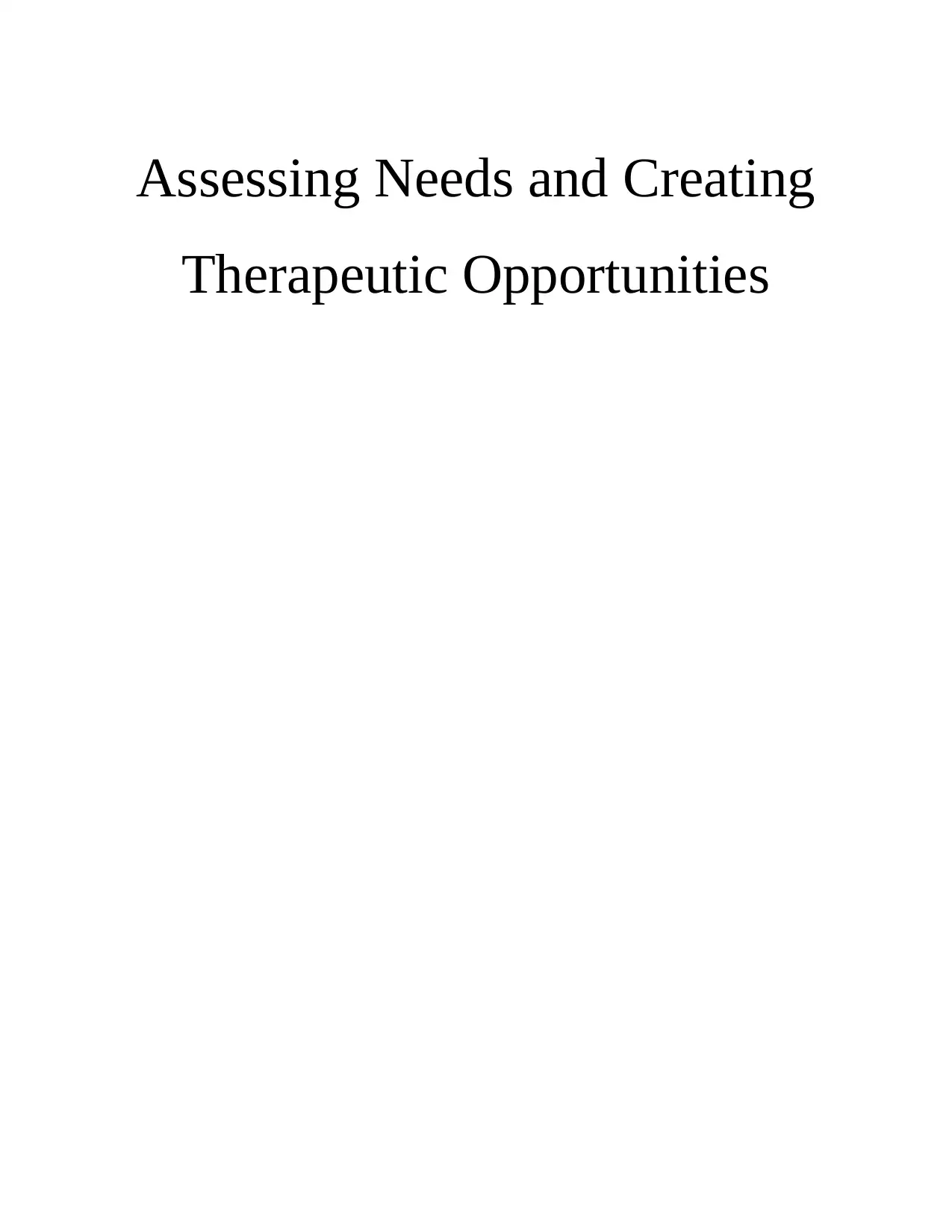
Assessing Needs and Creating
Therapeutic Opportunities
Therapeutic Opportunities
Paraphrase This Document
Need a fresh take? Get an instant paraphrase of this document with our AI Paraphraser
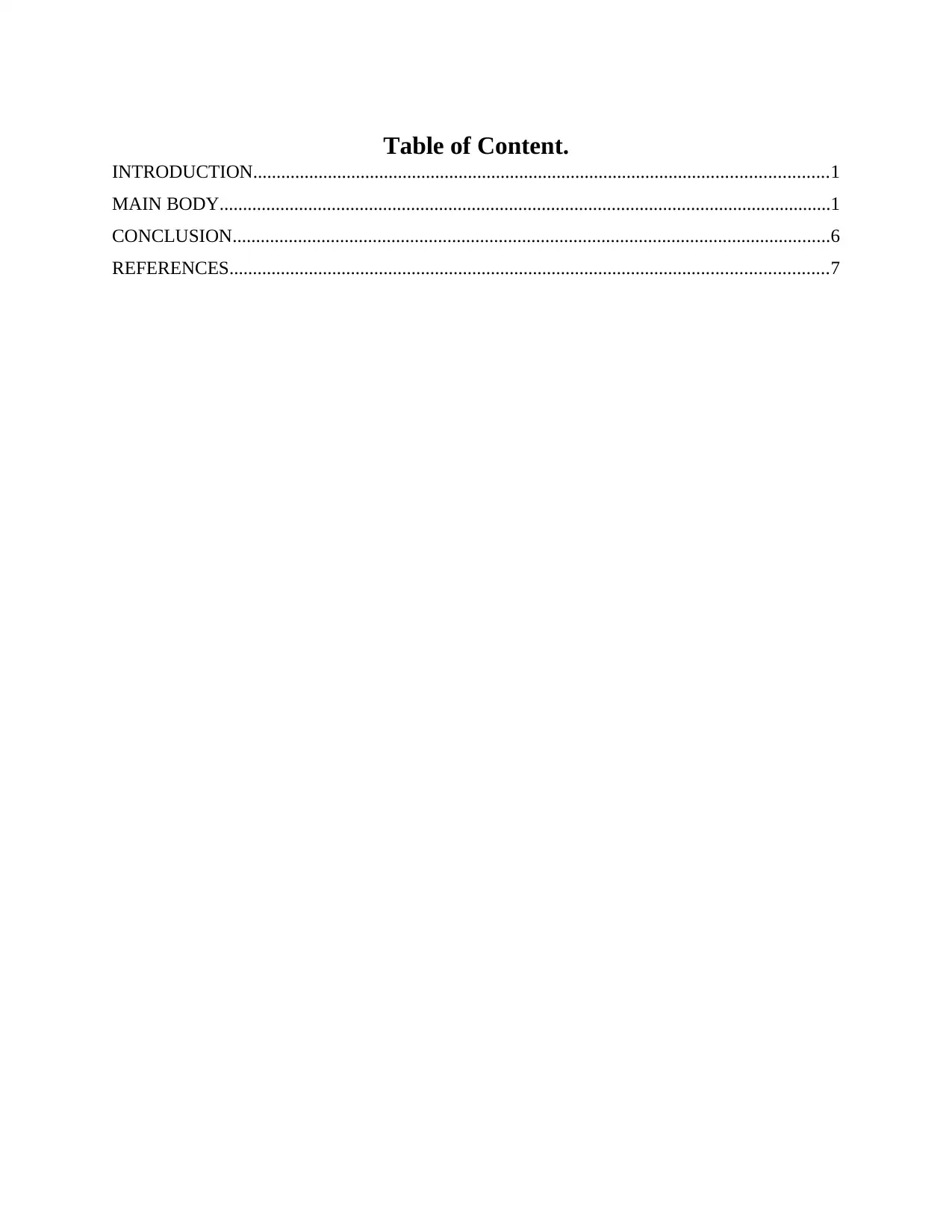
Table of Content.
INTRODUCTION...........................................................................................................................1
MAIN BODY...................................................................................................................................1
CONCLUSION................................................................................................................................6
REFERENCES................................................................................................................................7
INTRODUCTION...........................................................................................................................1
MAIN BODY...................................................................................................................................1
CONCLUSION................................................................................................................................6
REFERENCES................................................................................................................................7
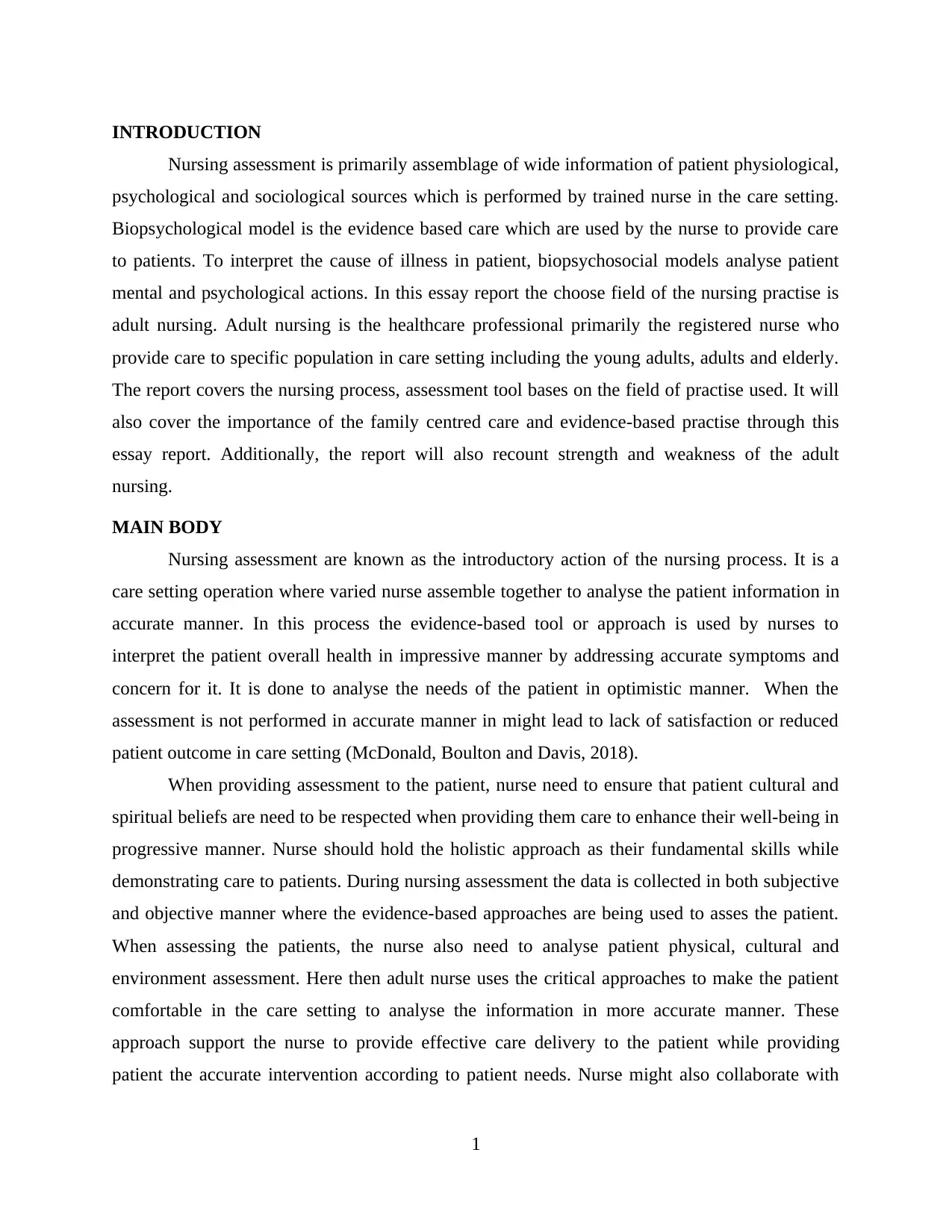
INTRODUCTION
Nursing assessment is primarily assemblage of wide information of patient physiological,
psychological and sociological sources which is performed by trained nurse in the care setting.
Biopsychological model is the evidence based care which are used by the nurse to provide care
to patients. To interpret the cause of illness in patient, biopsychosocial models analyse patient
mental and psychological actions. In this essay report the choose field of the nursing practise is
adult nursing. Adult nursing is the healthcare professional primarily the registered nurse who
provide care to specific population in care setting including the young adults, adults and elderly.
The report covers the nursing process, assessment tool bases on the field of practise used. It will
also cover the importance of the family centred care and evidence-based practise through this
essay report. Additionally, the report will also recount strength and weakness of the adult
nursing.
MAIN BODY
Nursing assessment are known as the introductory action of the nursing process. It is a
care setting operation where varied nurse assemble together to analyse the patient information in
accurate manner. In this process the evidence-based tool or approach is used by nurses to
interpret the patient overall health in impressive manner by addressing accurate symptoms and
concern for it. It is done to analyse the needs of the patient in optimistic manner. When the
assessment is not performed in accurate manner in might lead to lack of satisfaction or reduced
patient outcome in care setting (McDonald, Boulton and Davis, 2018).
When providing assessment to the patient, nurse need to ensure that patient cultural and
spiritual beliefs are need to be respected when providing them care to enhance their well-being in
progressive manner. Nurse should hold the holistic approach as their fundamental skills while
demonstrating care to patients. During nursing assessment the data is collected in both subjective
and objective manner where the evidence-based approaches are being used to asses the patient.
When assessing the patients, the nurse also need to analyse patient physical, cultural and
environment assessment. Here then adult nurse uses the critical approaches to make the patient
comfortable in the care setting to analyse the information in more accurate manner. These
approach support the nurse to provide effective care delivery to the patient while providing
patient the accurate intervention according to patient needs. Nurse might also collaborate with
1
Nursing assessment is primarily assemblage of wide information of patient physiological,
psychological and sociological sources which is performed by trained nurse in the care setting.
Biopsychological model is the evidence based care which are used by the nurse to provide care
to patients. To interpret the cause of illness in patient, biopsychosocial models analyse patient
mental and psychological actions. In this essay report the choose field of the nursing practise is
adult nursing. Adult nursing is the healthcare professional primarily the registered nurse who
provide care to specific population in care setting including the young adults, adults and elderly.
The report covers the nursing process, assessment tool bases on the field of practise used. It will
also cover the importance of the family centred care and evidence-based practise through this
essay report. Additionally, the report will also recount strength and weakness of the adult
nursing.
MAIN BODY
Nursing assessment are known as the introductory action of the nursing process. It is a
care setting operation where varied nurse assemble together to analyse the patient information in
accurate manner. In this process the evidence-based tool or approach is used by nurses to
interpret the patient overall health in impressive manner by addressing accurate symptoms and
concern for it. It is done to analyse the needs of the patient in optimistic manner. When the
assessment is not performed in accurate manner in might lead to lack of satisfaction or reduced
patient outcome in care setting (McDonald, Boulton and Davis, 2018).
When providing assessment to the patient, nurse need to ensure that patient cultural and
spiritual beliefs are need to be respected when providing them care to enhance their well-being in
progressive manner. Nurse should hold the holistic approach as their fundamental skills while
demonstrating care to patients. During nursing assessment the data is collected in both subjective
and objective manner where the evidence-based approaches are being used to asses the patient.
When assessing the patients, the nurse also need to analyse patient physical, cultural and
environment assessment. Here then adult nurse uses the critical approaches to make the patient
comfortable in the care setting to analyse the information in more accurate manner. These
approach support the nurse to provide effective care delivery to the patient while providing
patient the accurate intervention according to patient needs. Nurse might also collaborate with
1
⊘ This is a preview!⊘
Do you want full access?
Subscribe today to unlock all pages.

Trusted by 1+ million students worldwide
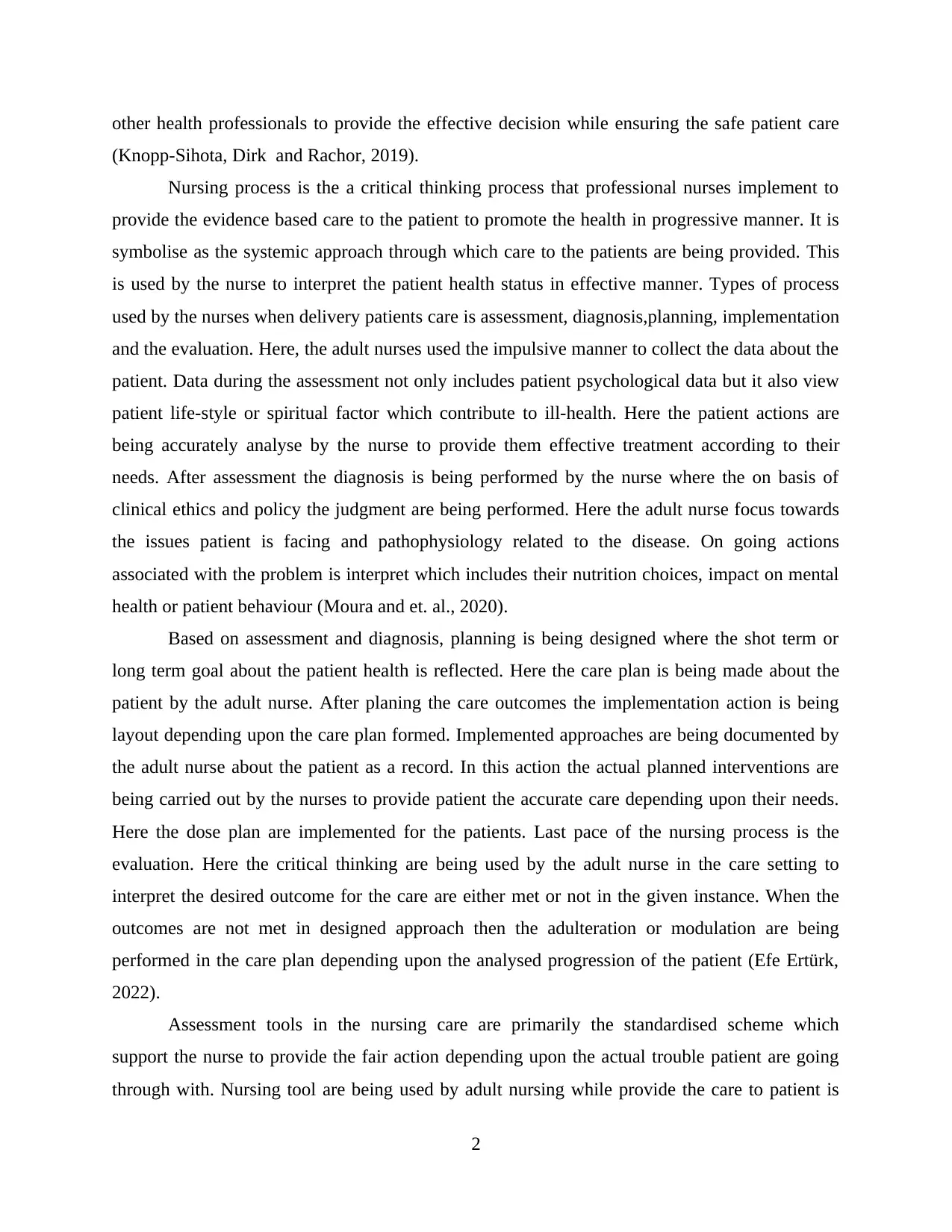
other health professionals to provide the effective decision while ensuring the safe patient care
(Knopp-Sihota, Dirk and Rachor, 2019).
Nursing process is the a critical thinking process that professional nurses implement to
provide the evidence based care to the patient to promote the health in progressive manner. It is
symbolise as the systemic approach through which care to the patients are being provided. This
is used by the nurse to interpret the patient health status in effective manner. Types of process
used by the nurses when delivery patients care is assessment, diagnosis,planning, implementation
and the evaluation. Here, the adult nurses used the impulsive manner to collect the data about the
patient. Data during the assessment not only includes patient psychological data but it also view
patient life-style or spiritual factor which contribute to ill-health. Here the patient actions are
being accurately analyse by the nurse to provide them effective treatment according to their
needs. After assessment the diagnosis is being performed by the nurse where the on basis of
clinical ethics and policy the judgment are being performed. Here the adult nurse focus towards
the issues patient is facing and pathophysiology related to the disease. On going actions
associated with the problem is interpret which includes their nutrition choices, impact on mental
health or patient behaviour (Moura and et. al., 2020).
Based on assessment and diagnosis, planning is being designed where the shot term or
long term goal about the patient health is reflected. Here the care plan is being made about the
patient by the adult nurse. After planing the care outcomes the implementation action is being
layout depending upon the care plan formed. Implemented approaches are being documented by
the adult nurse about the patient as a record. In this action the actual planned interventions are
being carried out by the nurses to provide patient the accurate care depending upon their needs.
Here the dose plan are implemented for the patients. Last pace of the nursing process is the
evaluation. Here the critical thinking are being used by the adult nurse in the care setting to
interpret the desired outcome for the care are either met or not in the given instance. When the
outcomes are not met in designed approach then the adulteration or modulation are being
performed in the care plan depending upon the analysed progression of the patient (Efe Ertürk,
2022).
Assessment tools in the nursing care are primarily the standardised scheme which
support the nurse to provide the fair action depending upon the actual trouble patient are going
through with. Nursing tool are being used by adult nursing while provide the care to patient is
2
(Knopp-Sihota, Dirk and Rachor, 2019).
Nursing process is the a critical thinking process that professional nurses implement to
provide the evidence based care to the patient to promote the health in progressive manner. It is
symbolise as the systemic approach through which care to the patients are being provided. This
is used by the nurse to interpret the patient health status in effective manner. Types of process
used by the nurses when delivery patients care is assessment, diagnosis,planning, implementation
and the evaluation. Here, the adult nurses used the impulsive manner to collect the data about the
patient. Data during the assessment not only includes patient psychological data but it also view
patient life-style or spiritual factor which contribute to ill-health. Here the patient actions are
being accurately analyse by the nurse to provide them effective treatment according to their
needs. After assessment the diagnosis is being performed by the nurse where the on basis of
clinical ethics and policy the judgment are being performed. Here the adult nurse focus towards
the issues patient is facing and pathophysiology related to the disease. On going actions
associated with the problem is interpret which includes their nutrition choices, impact on mental
health or patient behaviour (Moura and et. al., 2020).
Based on assessment and diagnosis, planning is being designed where the shot term or
long term goal about the patient health is reflected. Here the care plan is being made about the
patient by the adult nurse. After planing the care outcomes the implementation action is being
layout depending upon the care plan formed. Implemented approaches are being documented by
the adult nurse about the patient as a record. In this action the actual planned interventions are
being carried out by the nurses to provide patient the accurate care depending upon their needs.
Here the dose plan are implemented for the patients. Last pace of the nursing process is the
evaluation. Here the critical thinking are being used by the adult nurse in the care setting to
interpret the desired outcome for the care are either met or not in the given instance. When the
outcomes are not met in designed approach then the adulteration or modulation are being
performed in the care plan depending upon the analysed progression of the patient (Efe Ertürk,
2022).
Assessment tools in the nursing care are primarily the standardised scheme which
support the nurse to provide the fair action depending upon the actual trouble patient are going
through with. Nursing tool are being used by adult nursing while provide the care to patient is
2
Paraphrase This Document
Need a fresh take? Get an instant paraphrase of this document with our AI Paraphraser
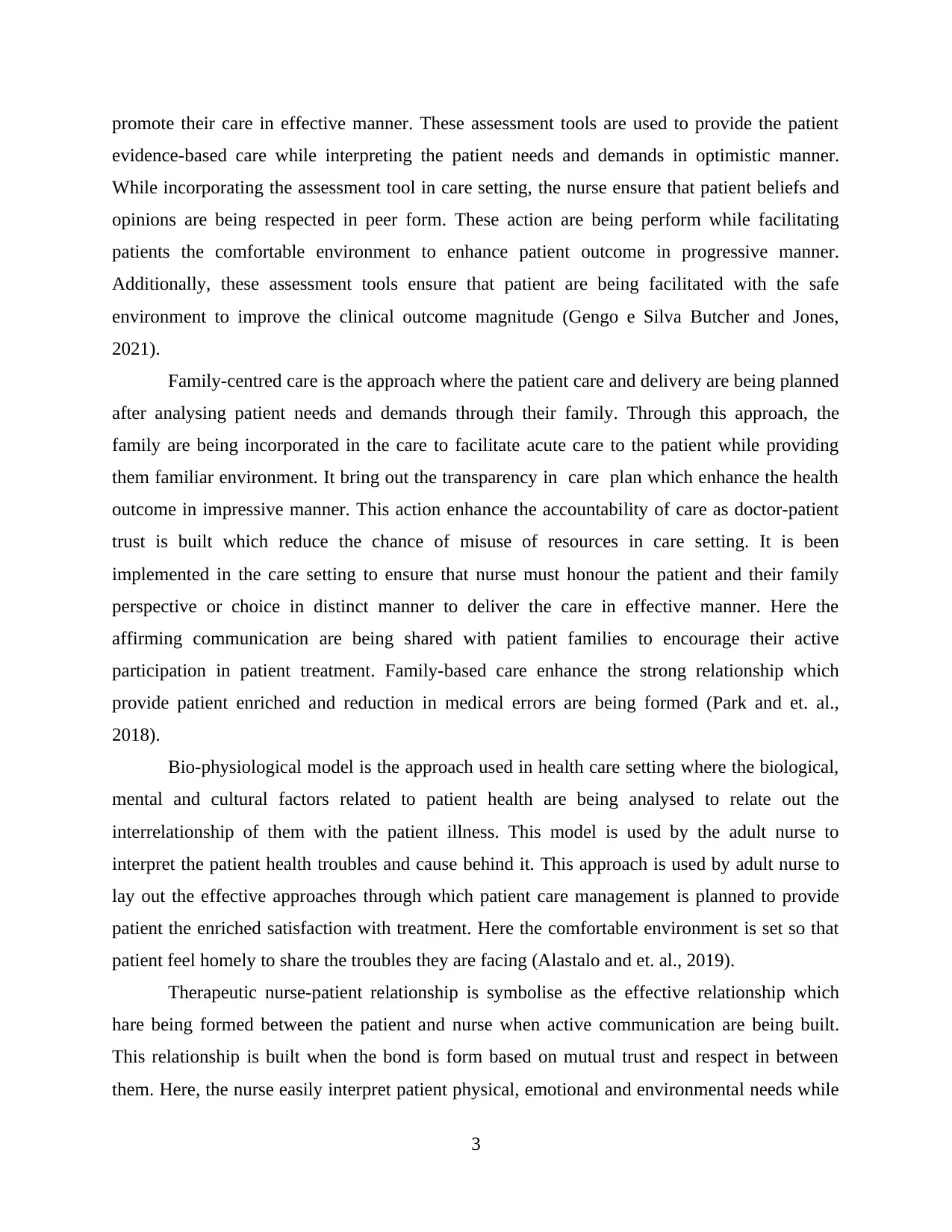
promote their care in effective manner. These assessment tools are used to provide the patient
evidence-based care while interpreting the patient needs and demands in optimistic manner.
While incorporating the assessment tool in care setting, the nurse ensure that patient beliefs and
opinions are being respected in peer form. These action are being perform while facilitating
patients the comfortable environment to enhance patient outcome in progressive manner.
Additionally, these assessment tools ensure that patient are being facilitated with the safe
environment to improve the clinical outcome magnitude (Gengo e Silva Butcher and Jones,
2021).
Family-centred care is the approach where the patient care and delivery are being planned
after analysing patient needs and demands through their family. Through this approach, the
family are being incorporated in the care to facilitate acute care to the patient while providing
them familiar environment. It bring out the transparency in care plan which enhance the health
outcome in impressive manner. This action enhance the accountability of care as doctor-patient
trust is built which reduce the chance of misuse of resources in care setting. It is been
implemented in the care setting to ensure that nurse must honour the patient and their family
perspective or choice in distinct manner to deliver the care in effective manner. Here the
affirming communication are being shared with patient families to encourage their active
participation in patient treatment. Family-based care enhance the strong relationship which
provide patient enriched and reduction in medical errors are being formed (Park and et. al.,
2018).
Bio-physiological model is the approach used in health care setting where the biological,
mental and cultural factors related to patient health are being analysed to relate out the
interrelationship of them with the patient illness. This model is used by the adult nurse to
interpret the patient health troubles and cause behind it. This approach is used by adult nurse to
lay out the effective approaches through which patient care management is planned to provide
patient the enriched satisfaction with treatment. Here the comfortable environment is set so that
patient feel homely to share the troubles they are facing (Alastalo and et. al., 2019).
Therapeutic nurse-patient relationship is symbolise as the effective relationship which
hare being formed between the patient and nurse when active communication are being built.
This relationship is built when the bond is form based on mutual trust and respect in between
them. Here, the nurse easily interpret patient physical, emotional and environmental needs while
3
evidence-based care while interpreting the patient needs and demands in optimistic manner.
While incorporating the assessment tool in care setting, the nurse ensure that patient beliefs and
opinions are being respected in peer form. These action are being perform while facilitating
patients the comfortable environment to enhance patient outcome in progressive manner.
Additionally, these assessment tools ensure that patient are being facilitated with the safe
environment to improve the clinical outcome magnitude (Gengo e Silva Butcher and Jones,
2021).
Family-centred care is the approach where the patient care and delivery are being planned
after analysing patient needs and demands through their family. Through this approach, the
family are being incorporated in the care to facilitate acute care to the patient while providing
them familiar environment. It bring out the transparency in care plan which enhance the health
outcome in impressive manner. This action enhance the accountability of care as doctor-patient
trust is built which reduce the chance of misuse of resources in care setting. It is been
implemented in the care setting to ensure that nurse must honour the patient and their family
perspective or choice in distinct manner to deliver the care in effective manner. Here the
affirming communication are being shared with patient families to encourage their active
participation in patient treatment. Family-based care enhance the strong relationship which
provide patient enriched and reduction in medical errors are being formed (Park and et. al.,
2018).
Bio-physiological model is the approach used in health care setting where the biological,
mental and cultural factors related to patient health are being analysed to relate out the
interrelationship of them with the patient illness. This model is used by the adult nurse to
interpret the patient health troubles and cause behind it. This approach is used by adult nurse to
lay out the effective approaches through which patient care management is planned to provide
patient the enriched satisfaction with treatment. Here the comfortable environment is set so that
patient feel homely to share the troubles they are facing (Alastalo and et. al., 2019).
Therapeutic nurse-patient relationship is symbolise as the effective relationship which
hare being formed between the patient and nurse when active communication are being built.
This relationship is built when the bond is form based on mutual trust and respect in between
them. Here, the nurse easily interpret patient physical, emotional and environmental needs while
3
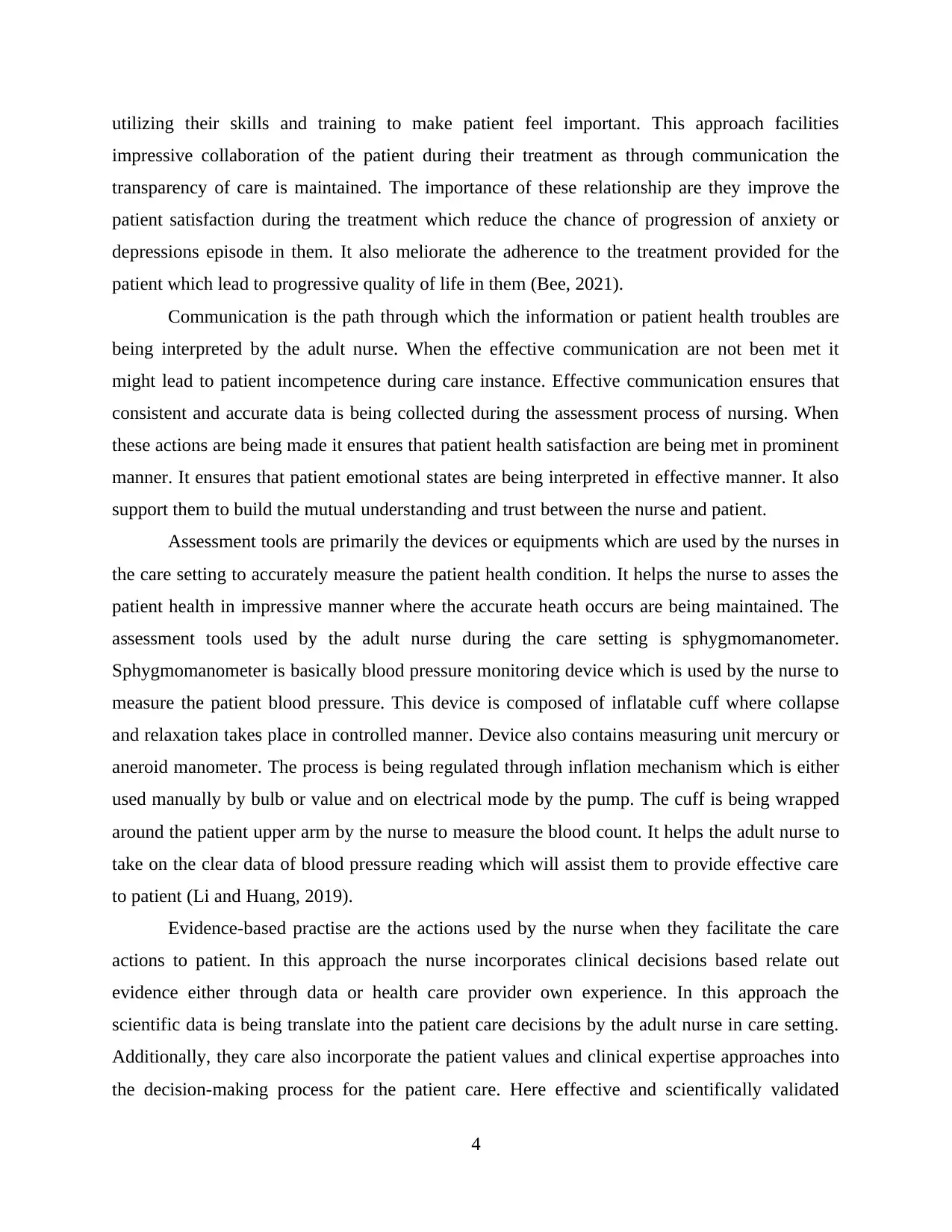
utilizing their skills and training to make patient feel important. This approach facilities
impressive collaboration of the patient during their treatment as through communication the
transparency of care is maintained. The importance of these relationship are they improve the
patient satisfaction during the treatment which reduce the chance of progression of anxiety or
depressions episode in them. It also meliorate the adherence to the treatment provided for the
patient which lead to progressive quality of life in them (Bee, 2021).
Communication is the path through which the information or patient health troubles are
being interpreted by the adult nurse. When the effective communication are not been met it
might lead to patient incompetence during care instance. Effective communication ensures that
consistent and accurate data is being collected during the assessment process of nursing. When
these actions are being made it ensures that patient health satisfaction are being met in prominent
manner. It ensures that patient emotional states are being interpreted in effective manner. It also
support them to build the mutual understanding and trust between the nurse and patient.
Assessment tools are primarily the devices or equipments which are used by the nurses in
the care setting to accurately measure the patient health condition. It helps the nurse to asses the
patient health in impressive manner where the accurate heath occurs are being maintained. The
assessment tools used by the adult nurse during the care setting is sphygmomanometer.
Sphygmomanometer is basically blood pressure monitoring device which is used by the nurse to
measure the patient blood pressure. This device is composed of inflatable cuff where collapse
and relaxation takes place in controlled manner. Device also contains measuring unit mercury or
aneroid manometer. The process is being regulated through inflation mechanism which is either
used manually by bulb or value and on electrical mode by the pump. The cuff is being wrapped
around the patient upper arm by the nurse to measure the blood count. It helps the adult nurse to
take on the clear data of blood pressure reading which will assist them to provide effective care
to patient (Li and Huang, 2019).
Evidence-based practise are the actions used by the nurse when they facilitate the care
actions to patient. In this approach the nurse incorporates clinical decisions based relate out
evidence either through data or health care provider own experience. In this approach the
scientific data is being translate into the patient care decisions by the adult nurse in care setting.
Additionally, they care also incorporate the patient values and clinical expertise approaches into
the decision-making process for the patient care. Here effective and scientifically validated
4
impressive collaboration of the patient during their treatment as through communication the
transparency of care is maintained. The importance of these relationship are they improve the
patient satisfaction during the treatment which reduce the chance of progression of anxiety or
depressions episode in them. It also meliorate the adherence to the treatment provided for the
patient which lead to progressive quality of life in them (Bee, 2021).
Communication is the path through which the information or patient health troubles are
being interpreted by the adult nurse. When the effective communication are not been met it
might lead to patient incompetence during care instance. Effective communication ensures that
consistent and accurate data is being collected during the assessment process of nursing. When
these actions are being made it ensures that patient health satisfaction are being met in prominent
manner. It ensures that patient emotional states are being interpreted in effective manner. It also
support them to build the mutual understanding and trust between the nurse and patient.
Assessment tools are primarily the devices or equipments which are used by the nurses in
the care setting to accurately measure the patient health condition. It helps the nurse to asses the
patient health in impressive manner where the accurate heath occurs are being maintained. The
assessment tools used by the adult nurse during the care setting is sphygmomanometer.
Sphygmomanometer is basically blood pressure monitoring device which is used by the nurse to
measure the patient blood pressure. This device is composed of inflatable cuff where collapse
and relaxation takes place in controlled manner. Device also contains measuring unit mercury or
aneroid manometer. The process is being regulated through inflation mechanism which is either
used manually by bulb or value and on electrical mode by the pump. The cuff is being wrapped
around the patient upper arm by the nurse to measure the blood count. It helps the adult nurse to
take on the clear data of blood pressure reading which will assist them to provide effective care
to patient (Li and Huang, 2019).
Evidence-based practise are the actions used by the nurse when they facilitate the care
actions to patient. In this approach the nurse incorporates clinical decisions based relate out
evidence either through data or health care provider own experience. In this approach the
scientific data is being translate into the patient care decisions by the adult nurse in care setting.
Additionally, they care also incorporate the patient values and clinical expertise approaches into
the decision-making process for the patient care. Here effective and scientifically validated
4
⊘ This is a preview!⊘
Do you want full access?
Subscribe today to unlock all pages.

Trusted by 1+ million students worldwide
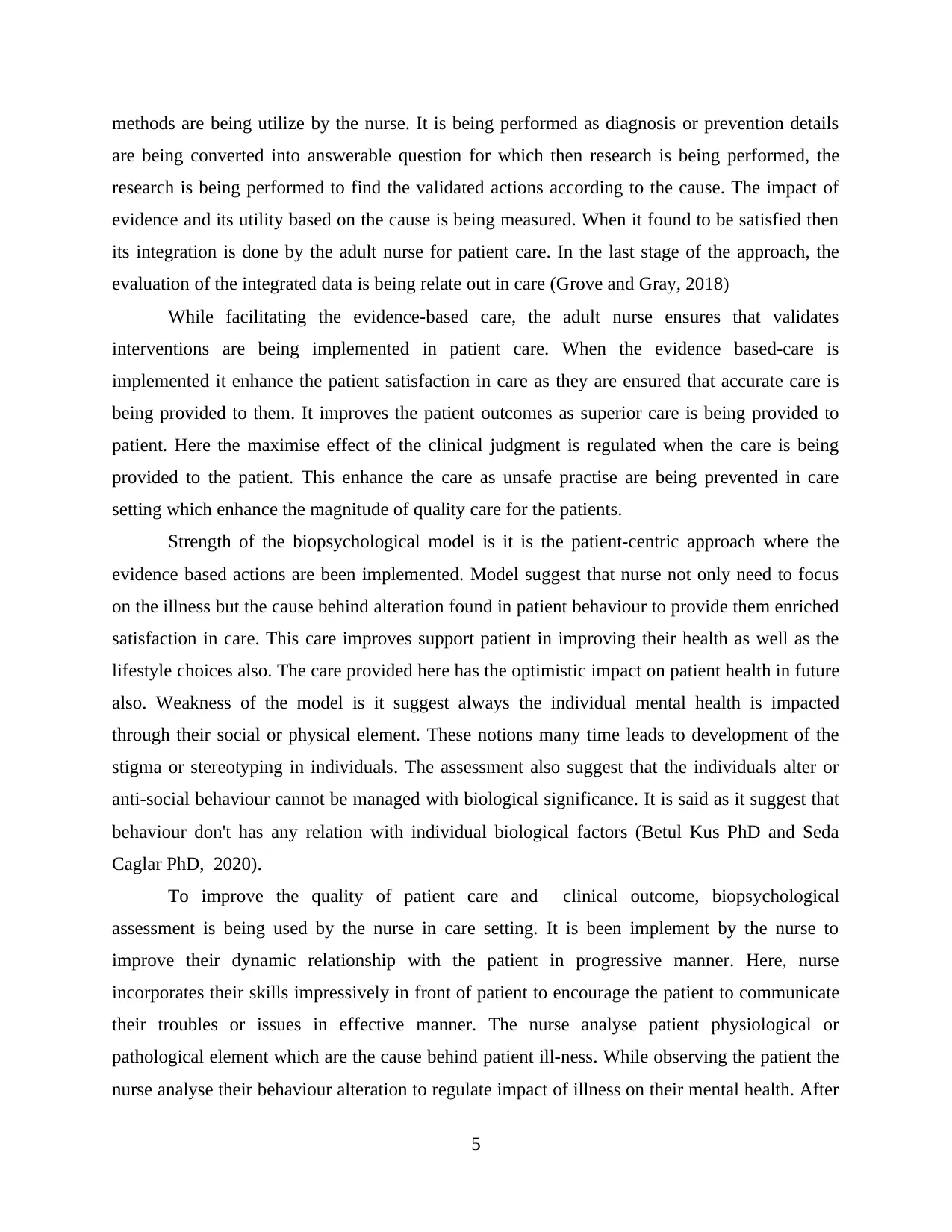
methods are being utilize by the nurse. It is being performed as diagnosis or prevention details
are being converted into answerable question for which then research is being performed, the
research is being performed to find the validated actions according to the cause. The impact of
evidence and its utility based on the cause is being measured. When it found to be satisfied then
its integration is done by the adult nurse for patient care. In the last stage of the approach, the
evaluation of the integrated data is being relate out in care (Grove and Gray, 2018)
While facilitating the evidence-based care, the adult nurse ensures that validates
interventions are being implemented in patient care. When the evidence based-care is
implemented it enhance the patient satisfaction in care as they are ensured that accurate care is
being provided to them. It improves the patient outcomes as superior care is being provided to
patient. Here the maximise effect of the clinical judgment is regulated when the care is being
provided to the patient. This enhance the care as unsafe practise are being prevented in care
setting which enhance the magnitude of quality care for the patients.
Strength of the biopsychological model is it is the patient-centric approach where the
evidence based actions are been implemented. Model suggest that nurse not only need to focus
on the illness but the cause behind alteration found in patient behaviour to provide them enriched
satisfaction in care. This care improves support patient in improving their health as well as the
lifestyle choices also. The care provided here has the optimistic impact on patient health in future
also. Weakness of the model is it suggest always the individual mental health is impacted
through their social or physical element. These notions many time leads to development of the
stigma or stereotyping in individuals. The assessment also suggest that the individuals alter or
anti-social behaviour cannot be managed with biological significance. It is said as it suggest that
behaviour don't has any relation with individual biological factors (Betul Kus PhD and Seda
Caglar PhD, 2020).
To improve the quality of patient care and clinical outcome, biopsychological
assessment is being used by the nurse in care setting. It is been implement by the nurse to
improve their dynamic relationship with the patient in progressive manner. Here, nurse
incorporates their skills impressively in front of patient to encourage the patient to communicate
their troubles or issues in effective manner. The nurse analyse patient physiological or
pathological element which are the cause behind patient ill-ness. While observing the patient the
nurse analyse their behaviour alteration to regulate impact of illness on their mental health. After
5
are being converted into answerable question for which then research is being performed, the
research is being performed to find the validated actions according to the cause. The impact of
evidence and its utility based on the cause is being measured. When it found to be satisfied then
its integration is done by the adult nurse for patient care. In the last stage of the approach, the
evaluation of the integrated data is being relate out in care (Grove and Gray, 2018)
While facilitating the evidence-based care, the adult nurse ensures that validates
interventions are being implemented in patient care. When the evidence based-care is
implemented it enhance the patient satisfaction in care as they are ensured that accurate care is
being provided to them. It improves the patient outcomes as superior care is being provided to
patient. Here the maximise effect of the clinical judgment is regulated when the care is being
provided to the patient. This enhance the care as unsafe practise are being prevented in care
setting which enhance the magnitude of quality care for the patients.
Strength of the biopsychological model is it is the patient-centric approach where the
evidence based actions are been implemented. Model suggest that nurse not only need to focus
on the illness but the cause behind alteration found in patient behaviour to provide them enriched
satisfaction in care. This care improves support patient in improving their health as well as the
lifestyle choices also. The care provided here has the optimistic impact on patient health in future
also. Weakness of the model is it suggest always the individual mental health is impacted
through their social or physical element. These notions many time leads to development of the
stigma or stereotyping in individuals. The assessment also suggest that the individuals alter or
anti-social behaviour cannot be managed with biological significance. It is said as it suggest that
behaviour don't has any relation with individual biological factors (Betul Kus PhD and Seda
Caglar PhD, 2020).
To improve the quality of patient care and clinical outcome, biopsychological
assessment is being used by the nurse in care setting. It is been implement by the nurse to
improve their dynamic relationship with the patient in progressive manner. Here, nurse
incorporates their skills impressively in front of patient to encourage the patient to communicate
their troubles or issues in effective manner. The nurse analyse patient physiological or
pathological element which are the cause behind patient ill-ness. While observing the patient the
nurse analyse their behaviour alteration to regulate impact of illness on their mental health. After
5
Paraphrase This Document
Need a fresh take? Get an instant paraphrase of this document with our AI Paraphraser
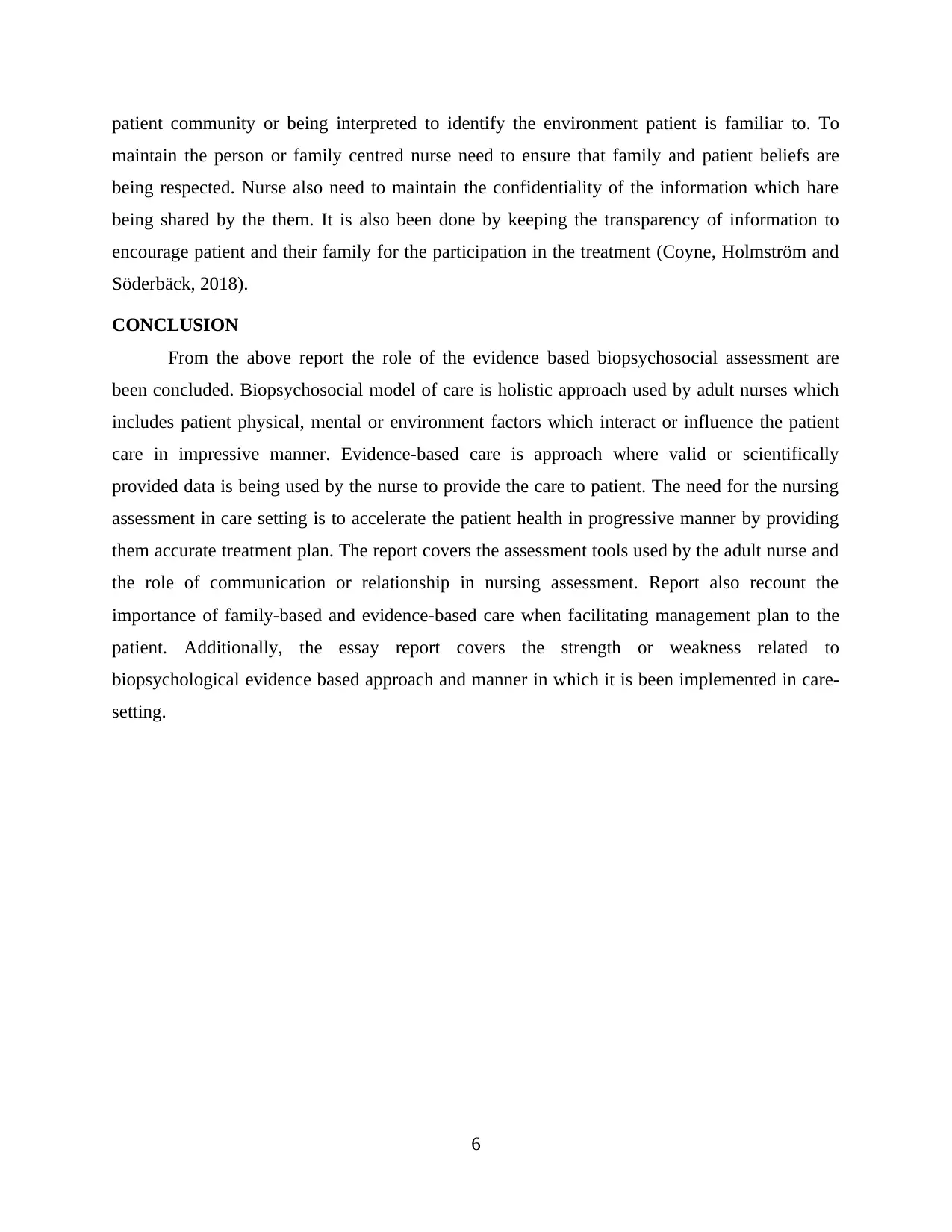
patient community or being interpreted to identify the environment patient is familiar to. To
maintain the person or family centred nurse need to ensure that family and patient beliefs are
being respected. Nurse also need to maintain the confidentiality of the information which hare
being shared by the them. It is also been done by keeping the transparency of information to
encourage patient and their family for the participation in the treatment (Coyne, Holmström and
Söderbäck, 2018).
CONCLUSION
From the above report the role of the evidence based biopsychosocial assessment are
been concluded. Biopsychosocial model of care is holistic approach used by adult nurses which
includes patient physical, mental or environment factors which interact or influence the patient
care in impressive manner. Evidence-based care is approach where valid or scientifically
provided data is being used by the nurse to provide the care to patient. The need for the nursing
assessment in care setting is to accelerate the patient health in progressive manner by providing
them accurate treatment plan. The report covers the assessment tools used by the adult nurse and
the role of communication or relationship in nursing assessment. Report also recount the
importance of family-based and evidence-based care when facilitating management plan to the
patient. Additionally, the essay report covers the strength or weakness related to
biopsychological evidence based approach and manner in which it is been implemented in care-
setting.
6
maintain the person or family centred nurse need to ensure that family and patient beliefs are
being respected. Nurse also need to maintain the confidentiality of the information which hare
being shared by the them. It is also been done by keeping the transparency of information to
encourage patient and their family for the participation in the treatment (Coyne, Holmström and
Söderbäck, 2018).
CONCLUSION
From the above report the role of the evidence based biopsychosocial assessment are
been concluded. Biopsychosocial model of care is holistic approach used by adult nurses which
includes patient physical, mental or environment factors which interact or influence the patient
care in impressive manner. Evidence-based care is approach where valid or scientifically
provided data is being used by the nurse to provide the care to patient. The need for the nursing
assessment in care setting is to accelerate the patient health in progressive manner by providing
them accurate treatment plan. The report covers the assessment tools used by the adult nurse and
the role of communication or relationship in nursing assessment. Report also recount the
importance of family-based and evidence-based care when facilitating management plan to the
patient. Additionally, the essay report covers the strength or weakness related to
biopsychological evidence based approach and manner in which it is been implemented in care-
setting.
6
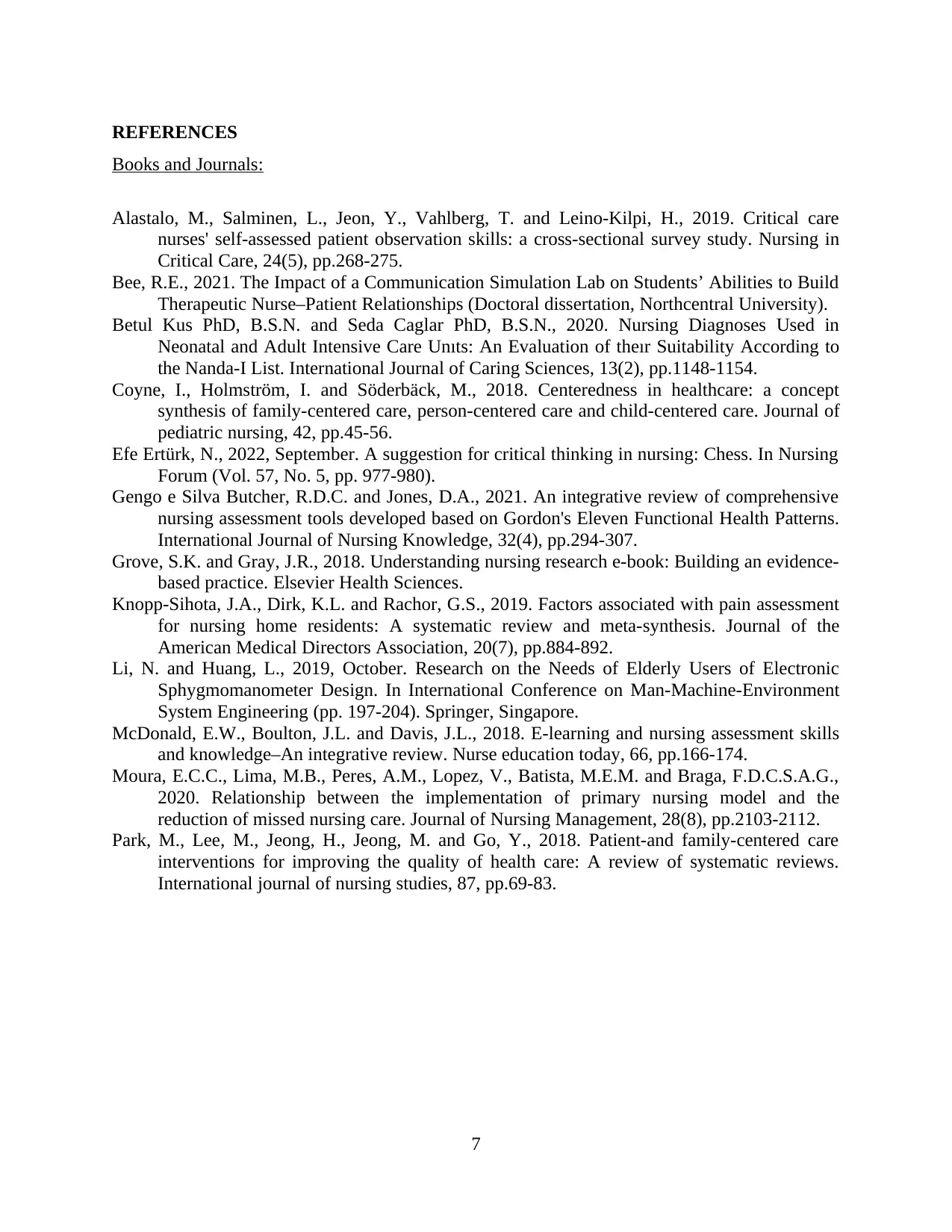
REFERENCES
Books and Journals:
Alastalo, M., Salminen, L., Jeon, Y., Vahlberg, T. and Leino‐Kilpi, H., 2019. Critical care
nurses' self‐assessed patient observation skills: a cross‐sectional survey study. Nursing in
Critical Care, 24(5), pp.268-275.
Bee, R.E., 2021. The Impact of a Communication Simulation Lab on Students’ Abilities to Build
Therapeutic Nurse–Patient Relationships (Doctoral dissertation, Northcentral University).
Betul Kus PhD, B.S.N. and Seda Caglar PhD, B.S.N., 2020. Nursing Diagnoses Used in
Neonatal and Adult Intensive Care Unıts: An Evaluation of theır Suitability According to
the Nanda-I List. International Journal of Caring Sciences, 13(2), pp.1148-1154.
Coyne, I., Holmström, I. and Söderbäck, M., 2018. Centeredness in healthcare: a concept
synthesis of family-centered care, person-centered care and child-centered care. Journal of
pediatric nursing, 42, pp.45-56.
Efe Ertürk, N., 2022, September. A suggestion for critical thinking in nursing: Chess. In Nursing
Forum (Vol. 57, No. 5, pp. 977-980).
Gengo e Silva Butcher, R.D.C. and Jones, D.A., 2021. An integrative review of comprehensive
nursing assessment tools developed based on Gordon's Eleven Functional Health Patterns.
International Journal of Nursing Knowledge, 32(4), pp.294-307.
Grove, S.K. and Gray, J.R., 2018. Understanding nursing research e-book: Building an evidence-
based practice. Elsevier Health Sciences.
Knopp-Sihota, J.A., Dirk, K.L. and Rachor, G.S., 2019. Factors associated with pain assessment
for nursing home residents: A systematic review and meta-synthesis. Journal of the
American Medical Directors Association, 20(7), pp.884-892.
Li, N. and Huang, L., 2019, October. Research on the Needs of Elderly Users of Electronic
Sphygmomanometer Design. In International Conference on Man-Machine-Environment
System Engineering (pp. 197-204). Springer, Singapore.
McDonald, E.W., Boulton, J.L. and Davis, J.L., 2018. E-learning and nursing assessment skills
and knowledge–An integrative review. Nurse education today, 66, pp.166-174.
Moura, E.C.C., Lima, M.B., Peres, A.M., Lopez, V., Batista, M.E.M. and Braga, F.D.C.S.A.G.,
2020. Relationship between the implementation of primary nursing model and the
reduction of missed nursing care. Journal of Nursing Management, 28(8), pp.2103-2112.
Park, M., Lee, M., Jeong, H., Jeong, M. and Go, Y., 2018. Patient-and family-centered care
interventions for improving the quality of health care: A review of systematic reviews.
International journal of nursing studies, 87, pp.69-83.
7
Books and Journals:
Alastalo, M., Salminen, L., Jeon, Y., Vahlberg, T. and Leino‐Kilpi, H., 2019. Critical care
nurses' self‐assessed patient observation skills: a cross‐sectional survey study. Nursing in
Critical Care, 24(5), pp.268-275.
Bee, R.E., 2021. The Impact of a Communication Simulation Lab on Students’ Abilities to Build
Therapeutic Nurse–Patient Relationships (Doctoral dissertation, Northcentral University).
Betul Kus PhD, B.S.N. and Seda Caglar PhD, B.S.N., 2020. Nursing Diagnoses Used in
Neonatal and Adult Intensive Care Unıts: An Evaluation of theır Suitability According to
the Nanda-I List. International Journal of Caring Sciences, 13(2), pp.1148-1154.
Coyne, I., Holmström, I. and Söderbäck, M., 2018. Centeredness in healthcare: a concept
synthesis of family-centered care, person-centered care and child-centered care. Journal of
pediatric nursing, 42, pp.45-56.
Efe Ertürk, N., 2022, September. A suggestion for critical thinking in nursing: Chess. In Nursing
Forum (Vol. 57, No. 5, pp. 977-980).
Gengo e Silva Butcher, R.D.C. and Jones, D.A., 2021. An integrative review of comprehensive
nursing assessment tools developed based on Gordon's Eleven Functional Health Patterns.
International Journal of Nursing Knowledge, 32(4), pp.294-307.
Grove, S.K. and Gray, J.R., 2018. Understanding nursing research e-book: Building an evidence-
based practice. Elsevier Health Sciences.
Knopp-Sihota, J.A., Dirk, K.L. and Rachor, G.S., 2019. Factors associated with pain assessment
for nursing home residents: A systematic review and meta-synthesis. Journal of the
American Medical Directors Association, 20(7), pp.884-892.
Li, N. and Huang, L., 2019, October. Research on the Needs of Elderly Users of Electronic
Sphygmomanometer Design. In International Conference on Man-Machine-Environment
System Engineering (pp. 197-204). Springer, Singapore.
McDonald, E.W., Boulton, J.L. and Davis, J.L., 2018. E-learning and nursing assessment skills
and knowledge–An integrative review. Nurse education today, 66, pp.166-174.
Moura, E.C.C., Lima, M.B., Peres, A.M., Lopez, V., Batista, M.E.M. and Braga, F.D.C.S.A.G.,
2020. Relationship between the implementation of primary nursing model and the
reduction of missed nursing care. Journal of Nursing Management, 28(8), pp.2103-2112.
Park, M., Lee, M., Jeong, H., Jeong, M. and Go, Y., 2018. Patient-and family-centered care
interventions for improving the quality of health care: A review of systematic reviews.
International journal of nursing studies, 87, pp.69-83.
7
⊘ This is a preview!⊘
Do you want full access?
Subscribe today to unlock all pages.

Trusted by 1+ million students worldwide
1 out of 9
Related Documents
Your All-in-One AI-Powered Toolkit for Academic Success.
+13062052269
info@desklib.com
Available 24*7 on WhatsApp / Email
![[object Object]](/_next/static/media/star-bottom.7253800d.svg)
Unlock your academic potential
Copyright © 2020–2025 A2Z Services. All Rights Reserved. Developed and managed by ZUCOL.





